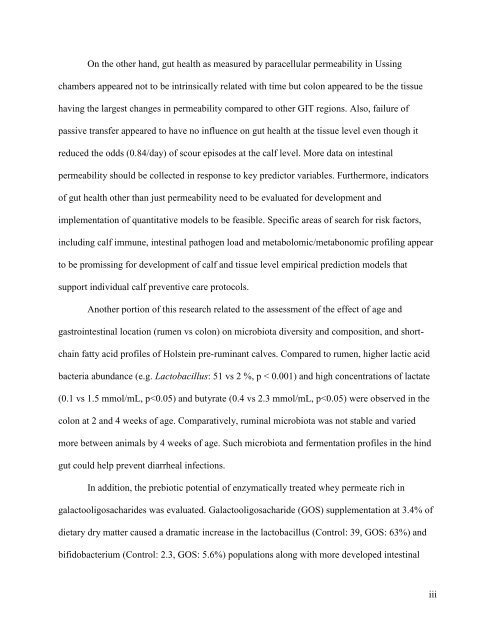- Page 1: CALF INTESTINAL HEALTH: ASSESSMENT
- Page 5 and 6: ACKNOWLEDGEMENTS I must thank my pa
- Page 7 and 8: DISCUSSION ........................
- Page 9 and 10: The resultant growth delay may have
- Page 11 and 12: High [cAMP] causes Cl - secretion i
- Page 13 and 14: paracellular flux, possibly due to
- Page 15 and 16: Finally, thorough understanding of
- Page 17 and 18: Soberon, F., E. Raffrenato, R. W. E
- Page 19 and 20: On the other hand, gut health as me
- Page 21 and 22: At the farm level though, these sco
- Page 23 and 24: of the new born calf with the proba
- Page 25 and 26: From exploratory plots (Figure 2.1)
- Page 27 and 28: transported to the laboratory for i
- Page 29 and 30: hypothesized, a quadratic function
- Page 31 and 32: Effect of age, GIT region and FPT o
- Page 33 and 34: coefficients vary from one to the o
- Page 35 and 36: passive immunity status (Chase et a
- Page 37 and 38: mucosa (Wyatt, 2000). Thus, for ins
- Page 39 and 40: Finally, more indicators of gut hea
- Page 41 and 42: Table 2.2. Estimated fixed effects,
- Page 43 and 44: Table 2.5. Effect of GIT locations,
- Page 45 and 46: a b c d Figure 2.1. Exploratory plo
- Page 47 and 48: Figure 2.4.Estimated probability of
- Page 49 and 50: NAHMS. 2010. National animal health
- Page 51 and 52: CHAPTER III MICROBIOTA COMPOSITION
- Page 53 and 54:
considered a monogastric (Orskov, 1
- Page 55 and 56:
MATERIALS AND METHODS Animals, Feed
- Page 57 and 58:
their nearest relative with a seque
- Page 59 and 60:
Microbial Community Composition. Th
- Page 61 and 62:
Intestinal SCFA Concentrations. Col
- Page 63 and 64:
ages, there is a visually evident d
- Page 65 and 66:
for most of the abundance differenc
- Page 67 and 68:
The PERMANOVA results (Table 3.13)
- Page 69 and 70:
In contrast, the rumen underwent ma
- Page 71 and 72:
lactate metabolism through extensiv
- Page 73 and 74:
CONCLUSION The rumen and colon of i
- Page 75 and 76:
Table 3.3. Regression coefficients
- Page 77 and 78:
Table 3.8. Contribution by specific
- Page 79 and 80:
Table 3.10. Indicator index values
- Page 81 and 82:
Figure 3.1. Richness and Shannon In
- Page 83 and 84:
a) b) Stress: 0.18 Stress: 0.18 c)
- Page 85 and 86:
Bacterial motility proteins Aromati
- Page 87 and 88:
REFERENCES Anderson, M. J. 2001. A
- Page 89 and 90:
Gibson, G. R. and X. Wang. 1994. Re
- Page 91 and 92:
Sutton, J. D., A. D. McGilliard, M.
- Page 93 and 94:
than GOS supplemented animals. Size
- Page 95 and 96:
score and, within block, treatments
- Page 97 and 98:
from which 5 µm thick sections wer
- Page 99 and 100:
Afterwards, to visually explore the
- Page 101 and 102:
to estimate the expected number of
- Page 103 and 104:
abundance of one or many of the sev
- Page 105 and 106:
characterized by more abundant Lact
- Page 107 and 108:
Visceral Organs Size Supplementatio
- Page 109 and 110:
Average daily water intake at 2, 4
- Page 111 and 112:
absorptive capacities are progressi
- Page 113 and 114:
Regarding functionality, the transp
- Page 115 and 116:
TABLES AND FIGURES Table 4.1. Nutri
- Page 117 and 118:
Table 4.5. SIMPER for genera drivin
- Page 119 and 120:
Table 4.7. Regression coefficients
- Page 121 and 122:
Table 4.11. Least squares means ±
- Page 123 and 124:
Table 4.15. Least squares means ±
- Page 125 and 126:
Lactobacillus Clostridium Square ro
- Page 127 and 128:
REFERENCES Anderson, M. J. 2001. A
- Page 129 and 130:
Heinrichs, A., C. Jones and B. Hein
- Page 131 and 132:
CHAPTER V EVALUATION OF VARIOUS ADD
- Page 133 and 134:
of the umami flavor, into the duode
- Page 135 and 136:
Dosing of glucose was based on prev
- Page 137 and 138:
3% hydrogen peroxide (15 min). Sect
- Page 139 and 140:
Genes selected to represent the GLP
- Page 141 and 142:
protein were tested as covariates.
- Page 143 and 144:
significant. Table 5.5 and Figure 5
- Page 145 and 146:
(average calf BW = 50 kg), which, f
- Page 147 and 148:
species specific dose response surf
- Page 149 and 150:
Table 5.2. Gene ID, accession numbe
- Page 151 and 152:
Table 5.4. Treatment means for plas
- Page 153 and 154:
a b 3OMG Control Gluc Sweet GS 3OMG
- Page 155 and 156:
R = 0.8, p < 0.001 Figure 5.3. NMDS
- Page 157 and 158:
Margolskee, R. F., J. Dyer, Z. Kokr



